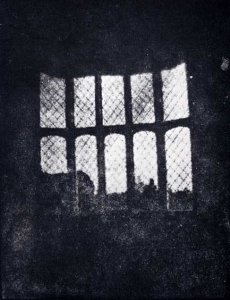
When we left Joseph Nicéphore Niépce he had managed to take the world’s first camera photograph, though it still took eight hours of exposure to create. In 1829 he entered into a partnership with Louis Daguerre, a French artist who was also trying to discover the means to make permanent photographic images. In 1832 they invented the physautotype, which used lavender oil residue to create an image which was positive when viewed against a black background. However, these still took an inconveniently long time to expose, and weren’t very durable.
Daguerre continued his experiments after Niépce died in 1833, but switched his focus to silver salts. Eventually he discovered a process which he named, after himself, the ‘daguerreotype’. He exposed a thin silver-plated copper sheet to iodine crystal vapour, which created light-sensitive silver iodide on its surface. This plate was then exposed in a camera—a process which originally took a long time, before Daguerre realised that the faint image from a short exposure could be ‘developed’ chemically into a visible image. In fact, sunlit scenes only required a few seconds of exposure, though longer was needed for more dimly-lit scenes. The faint image was treated with mercury vapour before being ‘fixed’, or made insensitive to further light exposure, by removing the remaining silver iodide with salt water. The resulting image wouldn’t fade, though it had to be kept under glass.
The earliest reliably dated daguerreotype was taken in 1837, and was a still-life of plaster casts. Using the daguerreotype technique, Daguerre took the first known candid image of a person in his "Boulevard du Temple" in 1838 (pictured). This was taken when he still relied on long exposures, and so most people, horses and vehicles in the image are invisible. However two small figures, a man having his boots polished and the young boy doing so, stood still long enough to be captured in the image. Another interesting feature of this process was that all resultant images were reversed, unless a mirror was used during exposure. Daguerrotypes remained the most popular photographic method for twenty years, until cheaper and easier methods replaced it by 1860.

Meanwhile in England, a scientist called William Henry Fox Talbot had been experimenting with sodium chloride, or table salt, and silver chloride, since 1834. After the daguerreotype was announced in 1839 he improved his technique, and in 1840 invented the calotype or talbotype. This used silver iodide, and sodium thiosulphate to fix the image. This created a translucent negative from which multiple positives could be made through contact printing. The image to the left is a positive image made from the oldest surviving photographic negative, which Talbot took in 1835. This ability to reproduce the images presented a clear advantage over daguerrotypes, which created one-off images. However, calotypes were not as sharp as daguerrotypes, and reproducing the images made the quality even worse still. Talbot spent the later years of his life making the mass reproduction of photographic images more practical and much less expensive by rendering photographs into ink on paper.
Images: https://upload.wikimedia.org/wikipedia/commons/thumb/d/d3/Boulevard_du_Temple_by_Daguerre.jpg/800px-Boulevard_du_Temple_by_Daguerre.jpg
https://upload.wikimedia.org/wikipedia/commons/b/be/Latticed_window_at_lacock_abbey_1835.jpg

0 Comment:
Be the first one to comment on this article.